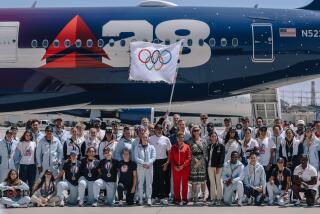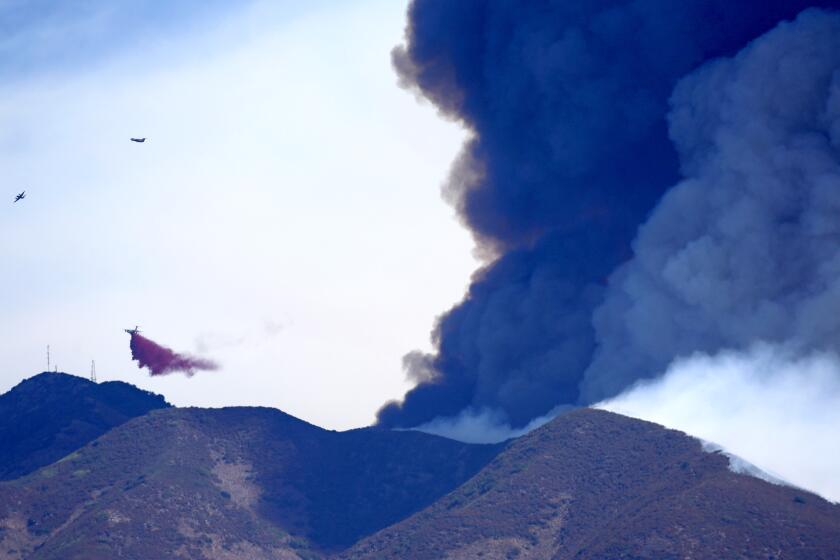Op-Ed: What L.A.’s Piggyback Yard Olympic planners can learn from Sydney
Every Angeleno who regularly takes the 5 Freeway past downtown has glimpsed the Piggyback Yard, a sprawling 125-acre stretch of Union Pacific railroad tracks etched into the shoulder of Lincoln Heights, between the Los Angeles River and the L.A. County-USC Medical Center. Home to an active rail yard and a pile of concrete aggregate, this plot of land (officially known as the L.A. Transportation Center) is now in the Olympics limelight, thanks to the L.A. bid committee’s scheme to transform it into the 2024 Olympic Village.
The plan for this village is far more ambitious than that of its predecessors at previous L.A. Olympics. In 1932, female athletes were housed in the Chapman Park Hotel on Wilshire, while male competitors lived in 500 new Baldwin Hills bungalows that were sold and removed, without a trace, after the Games. Olympic Village housing in 1984 became additional dormitories for local colleges.
Olympics planners will need to expand the scope of their thinking.
After the 2024 Games, by contrast, the village would become a new and permanent neighborhood. At a cool $1 billion ($925 million of it privately financed) that city analysts warn still may not be enough, the Olympic Village is the most expensive component of the 2024 plan. Details remain vague, as bid committee members try to figure out how to simultaneously please Olympics officials, residents and business owners, city budget makers, Union Pacific and the railroad’s largest shareholder, Philip Anschutz, whose Anschutz Entertainment Group owns a crucial Olympics venue, Staples Center.
But committee members are promising that everyone will win: After post-Games redevelopment, housing-scarce Los Angeles will have an entirely new neighborhood with a public park that could be the jewel of the L.A. River restoration project (the city’s future “linear Central Park,” as architect Frank Gehry calls it), providing a physical and cultural link between both sides of the river and producing a ripple effect of economic revitalization throughout the area.
In the meantime, there’s a historical precedent that’s worth examining as a hint of what’s to come.
For the 2000 Olympics, Sydney officials constructed an Olympic Village in the suburb of Homebush Bay, an industrial and solid-waste site that needed a costly remediation. They promised that, after the closing ceremony, they would turn Homebush Bay into an entirely new residential area with plentiful parks, which would connect the urban core to outlying areas. Sydney planners also promised to create a riverside development corridor and promote greater density, reversing the process of suburban sprawl. Sound familiar?
A decade and a half later, what did Sydney get? According to an analysis published in 2014 by researchers at Australia’s Monash University, the Olympic Park transformation did indeed provide more housing and brought in attractive corporate tenants, though not as many as desired. It also helped give residents of the low-occupancy suburbs better access to Sydney’s denser core, through the addition of main-road infrastructure and better rail links.
The project failed, however, to revitalize surrounding areas. Much of the surrounding land remains devoted to industrial use, and several nearby residential developments are still low density. Researchers attribute this failure to a lack of “permeability”: road, public transportation and pedestrian connections to the new park targeted only certain communities, while others were neglected. After a short-lived speculative boom, real estate prices rose only on the side of the park that enjoyed multiple access points; investment was lured away from the less permeable edge.
The Piggyback Yard isn’t the perfect analogy to Sydney. Unlike Homebush Bay in 2000, L.A.’s Olympic Village is just one piece of a larger revitalization effort already underway. The project area rests much closer to L.A.’s changing urban core than Homebush Bay does to Sydney’s. The momentum and proximity of downtown revitalization mean that communities around the Piggyback Yard are more likely to experience renewal than did those surrounding Homebush Bay.
That said, Los Angeles is facing a similar issue of permeability. Planners can easily integrate the post-Olympics site into the already thriving landscape of the Brewery arts complex to the north, and, via a proposed tramway, to the lofts, galleries and museums of the Arts District across the river to the west. But the ripple of public and private investment is unlikely to travel in the directions it is most needed: east and southeast.
Between the Piggyback Yard and its eastern neighbors of Boyle Heights, Aliso Village and a sliver of Lincoln Heights lies a wide moat of auto repair shops on North Mission Road. To reach across it, post-Olympics planners will need to expand the scope of their thinking, and earn the trust of those surrounding communities as well. (That trust appeared to be in short supply this year when the residents of Boyle Heights successfully resisted the transformation of Mariachi Plaza into a medical complex.)
There’s a good argument for redeveloping Mission Road. As much as 40% of the area’s working population walks or bikes to work, which means they may decide that access for pedestrians and cyclists to a stunning new park is worth the downsides of gentrification.
But if L.A. 2024’s planners hope to improve on Sydney’s record, they can’t leave the task of integrating surrounding areas to market forces alone. Without a 360-degree strategy, the Piggyback Yard could turn into an exclusive settlement for downtown artists, but not a true link across the river that knits the whole city together.
Justin Clark is an urban historian. He is writing a book on the transformation of 19th century Boston. Twitter: @Justin_T_Clark
Follow the Opinion section on Twitter @latimesopinion and Facebook
More to Read
A cure for the common opinion
Get thought-provoking perspectives with our weekly newsletter.
You may occasionally receive promotional content from the Los Angeles Times.










